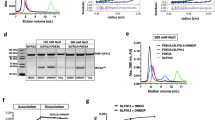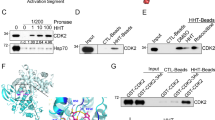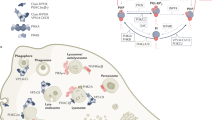Abstract
The mammalian target of rapamycin (mTOR) is a large, multidomain protein kinase, which plays a central role in the regulation of cell growth and has recently emerged as an essential target of survival signals in many types of human cancer cells. Here, we report the solution structures of complexes formed between the FKBP12-rapamycin binding (FRB) domain of mTOR and phosphatidic acid, an important cellular activator of the kinase, and between the FRB domain and a novel inhibitor (HTS-1). The overall structure of the FRB domain is very similar to that seen in the ternary complex formed with FKBP12 and the immunosuppressive drug rapamycin; however, there are significant changes within the rapamycin-binding site with important consequences for rational drug design. The surface of the FRB domain contains a number of distinctive features that have previously escaped attention, including a potential new regulatory site on the opposite face to that involved in the binding of rapamycin, which displays the features expected for a specific binding site for a small molecule. The interaction sites for phosphatidic acid and HTS-1 were found to closely match the site responsible for rapamycin binding. In addition, the structures determined for the FRB–phosphatidic acid and FRB–HTS-1 complexes revealed a striking similarity between the conformations of buried portions of the ligands and that seen for the rapamycin backbone in contact with the domain. Our findings further highlight the importance of the FRB domain in small molecule-mediated regulation of mTOR, demonstrate the ability to identify novel inhibitors of mTOR that bind tightly to the rapamycin-binding site in the absence of FKBP12, and identify a potential new regulatory site that may be exploited in the design of new anticancer drugs.
This is a preview of subscription content, access via your institution
Access options
Subscribe to this journal
Receive 50 print issues and online access
$259.00 per year
only $5.18 per issue
Buy this article
- Purchase on Springer Link
- Instant access to full article PDF
Prices may be subject to local taxes which are calculated during checkout







Similar content being viewed by others
Accession codes
References
Annis DA, Athanasopoulos J, Curran PJ, Felsch JS, Kalghatgi K, Lee WH et al. (2004). An affinity selection-mass spectrometry method for the identification of small molecule ligands from self-encoded combinatorial libraries—discovery of a novel antagonist of E-coli dihydrofolate reductase. Int J Mass Spectrom 238: 77–83.
Avila-Flores A, Santos T, Rincon E, Merida I . (2005). Modulation of the mammalian target of rapamycin pathway by diacylglycerol kinase-produced phosphatidic acid. J Biol Chem 280: 10091–10099.
Banaszynski LA, Liu CW, Wandless TJ . (2005). Characterization of the FKBP center dot rapamycin center dot FRB ternary complex. J Am Chem Soc 127: 4715–4721.
Bianco RB, Melisi D, Ciardiello F, Tortora G . (2006). Key cancer cell signal transduction pathways as therapeutic targets. Eur J Cancer 42: 290–294.
Brown EJ, Albers MW, Shin TB, Ichikawa K, Keith CT, Lane WS et al. (1994). A mammalian protein targeted by G1-arresting rapamycin–receptor complex. Nature 369: 756–758.
Chen J, Fang Y . (2002). A novel pathway regulating the mammalian target of rapamycin (mTOR) signaling. Biochem Pharmacol 64: 1071.
Chen YH, Zheng Y, Foster DA . (2003). Phospholipase D confers rapamycin resistance in human breast cancer cells. Oncogene 22: 3937–3942.
Choi JW, Chen J, Schreiber SL, Clardy J . (1996). Structure of the FKBP12-rapamycin complex interacting with the binding domain of human FRAP. Science 273: 239–242.
DeLano WL . (2002). The PyMOL molecular graphics system. http://www.pymol.org.
Dominguez C, Boelens R, Bonvin AM . (2003). HADDOCK: a protein–protein docking approach based on biochemical or biophysical information. J Am Chem Soc 125: 1731–1737.
Fang Y, Vilella-Bach M, Bachmann R, Flanigan A, Chen J . (2001). Phosphatidic acid-mediated mitogenic activation of mTOR signaling. Science 294: 1942–1945.
Farmer BT, Constantine KL, Goldfarb V, Friedrichs MS, Wittekind M, Yanchunas J et al. (1996). Localizing the NADP+ binding site on the MurB enzyme by NMR. Nat Struct Mol Biol 3: 995.
Foster DA . (2007). Regulation of mTOR by phosphatidic acid? Cancer Res 67: 1–4.
Guertin DA, Sabatini DM . (2005). An expanding role for mTOR in cancer. Trends Mol Med 11: 353–361.
Guntert P, Wuthrich K . (1991). Improved efficiency of protein structure calculations from NMR data using the program DIANA with redundant dihedral angle constraints. J Biomol NMR 1: 447–456.
Hancock JF . (2007). PA promoted to manager. Nat Cell Biol 9: 615–617.
Hara K, Maruki Y, Long XM, Yoshino K, Oshiro N, Hidayat S et al. (2002). Raptor, a binding partner of target of rapamycin (TOR), mediates TOR action. Cell 110: 177–189.
Hay N, Sonenberg N . (2004). Upstream and downstream of mTOR. Gene Dev 18: 1926–1945.
Heitman J, Movva NR, Hall MN . (1991). Targets for cell-cycle arrest by the immunosuppressant rapamycin in yeast. Science 253: 905–909.
Herrmann T, Guntert P, Wuthrich K . (2002). Protein NMR structure determination with automated NOE assignment using the new software CANDID and the torsion angle dynamics algorithm DYANA. J Mol Biol 319: 209–227.
Jacinto E, Loewith R, Schmidt A, Lin S, Ruegg MA, Hall A et al. (2004). Mammalian TOR complex 2 controls the actin cytoskeleton and is rapamycin insensitive. Nature Cell Biol 6: 1122–1128.
Kim DH, Sarbassov DD, Ali SM, King JE, Latek RR, Erdjument-Bromage H et al. (2002). MTOR interacts with raptor to form a nutrient-sensitive complex that signals to the cell growth machinery. Cell 110: 163–175.
Kleywegt GJ, Jones TA . (1997). Model building and refinement practice. Method Enzymol 277: 208–230.
Koharudin LM, Bonvin AM, Kaptein R, Boelens R . (2003). Use of very long-distance NOEs in a fully deuterated protein: an approach for rapid protein fold determination. J Magn Reson 163: 228–235.
Koradi R, Billeter M, Wuthrich K . (1996). MOLMOL: a program for display and analysis of macromolecular structures. J Mol Graph 14: 51–55.
Kunz J, Henriquez R, Schneider U, Deuterreinhard M, Movva NR, Hall MN . (1993). Target of rapamycin in yeast, Tor2, is an essential phosphatidylinositol kinase homolog required for G(1) progression. Cell 73: 585–596.
Laskowski RA, Rullmann JAC, MacArthur MW, Kaptein R, Thornton JM . (1996). AQUA and PROCHECK-NMR: programs for checking the quality of protein structures solved by NMR. J Biomol NMR 8: 477–486.
Leone M, Crowell KJ, Chen JH, Jung DW, Chiang GG, Sareth S et al. (2006). The FRB domain of mTOR: NMR solution structure and inhibitor design. Biochemistry 45: 10294–10302.
Loewith R, Jacinto E, Wullschleger S, Lorberg A, Crespo JL, Bonenfant D et al. (2002). Two TOR complexes, only one of which is rapamycin sensitive, have distinct roles in cell growth control. Mol Cell 10: 457–468.
Long XM, Ortiz-Vega S, Lin YS, Avruch J . (2005). Rheb binding to mammalian target of rapamycin (mTOR) is regulated by amino acid sufficiency. J Biol Chem 280: 23433–23436.
Manning BD . (2004). Balancing Akt with S6K: implications for both metabolic diseases and tumorigenesis. J Cell Biol 167: 399–403.
Mor A, Campi G, Du G, Zheng Y, Foster DA, Dustin ML et al. (2007). The lymphocyte function-associated antigen-1 receptor costimulates plasma membrane Ras via phospholipase D2. Nat Cell Biol 9: 713–719.
Muskett FW, Frenkiel TA, Feeney J, Freedman RB, Carr MD, Williamson RA . (1998). High resolution structure of the N-terminal domain of tissue inhibitor of metalloproteinases-2 and characterization of its interaction site with matrix metalloproteinase-3. J Biol Chem 273: 21736–21743.
Petroulakis E, Mamane Y, Le Bacquer O, Shahbazian D, Sonenberg N . (2006). mTOR signaling: implications for cancer and anticancer therapy. Br J Cancer 94: 195–199.
Sabatini DM, Erdjumentbromage H, Lui M, Tempst P, Snyder SH . (1994). Raft1—a mammalian protein that binds to Fkbp12 in a rapamycin-dependent fashion and is homologous to yeast tors. Cell 78: 35–43.
Sarbassov DD, Ali SM, Kim DH, Guertin DA, Latek RR, Erdjument-Bromage H et al. (2004). Rictor, a novel binding partner of mTOR, defines a rapamycin-insensitive and raptor-independent pathway that regulates the cytoskeleton. Curr Biol 14: 1296–1302.
Sarbassov DD, Ali SM, Sabatini DM . (2005). Growing roles for the mTOR pathway. Curr Opin Cell Biol 17: 596–603.
Thomas GV . (2006). mTOR and cancer: reason for dancing at the crossroads? Curr Opin Genet Dev 16: 78–84.
Veverka V, Lennie G, Crabbe T, Bird I, Taylor RJ, Carr MD . (2006). NMR assignment of the mTOR domain responsible for rapamycin binding. J Biomol NMR 36 (Suppl, 5): 3.
Vezina C, Kudelski A, Sehgal SN . (1975). Rapamycin (Ay-22,989), a new antifungal antibiotic. 1. Taxonomy of producing streptomycete and isolation of active principle. J Antibiot 28: 721–726.
Williamson RA, Carr MD, Frenkiel TA, Feeney J, Freedman RB . (1997). Mapping the binding site for matrix metalloproteinase on the N-terminal domain of the tissue inhibitor of metalloproteinases-2 by NMR chemical shift perturbation. Biochemistry 36: 13882–13889.
Wullschleger S, Loewith R, Hall MN . (2006). TOR signaling in growth and metabolism. Cell 124: 471–484.
Zhao C, Du G, Skowronek K, Frohman MA, Bar-Sagi D . (2007). Phospholipase D2-generated phosphatidic acid couples EGFR stimulation to Ras activation by Sos. Nat Cell Biol 9: 707–712.
Acknowledgements
This work was supported by UCB-Celltech Ltd and the Wellcome Trust. HTS-1 was identified through a high-throughput screen carried out by NeoGenesis Pharmaceuticals Inc., using their Automated Ligand Identification System (ALIS) and we thank Dr Huw Nash for his assistance.
Author information
Authors and Affiliations
Corresponding author
Additional information
Supplementary Information accompanies the paper on the Oncogene website (http://www.nature.com/onc).
Supplementary information
Rights and permissions
About this article
Cite this article
Veverka, V., Crabbe, T., Bird, I. et al. Structural characterization of the interaction of mTOR with phosphatidic acid and a novel class of inhibitor: compelling evidence for a central role of the FRB domain in small molecule-mediated regulation of mTOR. Oncogene 27, 585–595 (2008). https://doi.org/10.1038/sj.onc.1210693
Received:
Revised:
Accepted:
Published:
Issue Date:
DOI: https://doi.org/10.1038/sj.onc.1210693



